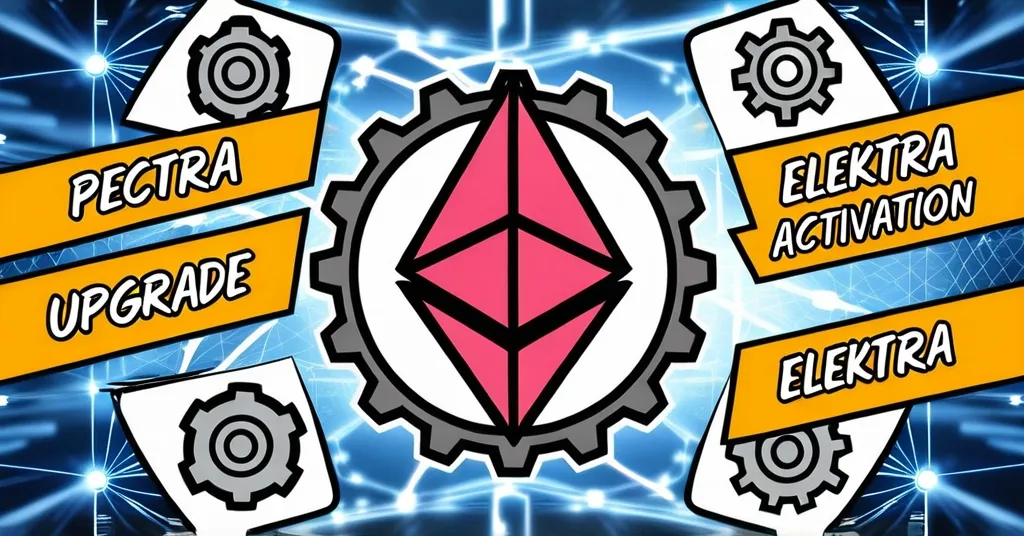Ethereum’s Pectra Upgrade: Devnet 5 Launched, Elektra Activated, March 2025 Mainnet Target

Ethereum’s Pectra Upgrade: Insights from ACDE #203 and the Launch of Pectra Devnet 5
Ethereum kicked off 2025 with the launch of Pectra Devnet 5 just 30 minutes before the first All Core Developers Execution (ACDE) call of the year. This meeting highlighted the upcoming Pectra upgrade, focusing on network efficiency and gas handling improvements with a target for mainnet activation in March 2025.
- Pectra Devnet 5 launched
- Elektra upgrade activated
- Multiple EIPs discussed
- Testnet timelines set
- Shadow forks for testing
The Ethereum community’s enthusiasm is palpable as they aim for significant enhancements through the Pectra upgrade. Pectra Devnet 5, a pre-release test network for the Pectra upgrade, allows developers to test new features and iron out issues before they go live. But, just like any exciting new gadget, it had its teething problems with gas estimation hiccups. Parithosh Jayanthi, EF DevOps Engineer, shared the initial feedback, urging developers to jump into the Devnet and utilize the Pectra Devnet 5 Dashboard for real-time troubleshooting.
The Elektra upgrade, which was activated just before the call, marks a crucial milestone within the Pectra framework. This upgrade aims to streamline the Ethereum network further, and Pectra Devnet 5 is the testing ground for these enhancements. Ethereum Improvement Proposals (EIPs), which are suggestions for changes or enhancements to the Ethereum network voted on by the community, were a major focus of the meeting.
Pectra Devnet 5 and Elektra Upgrade
Pectra Devnet 5 isn’t just a fancy name; it’s where the magic happens before the real show on the mainnet. It’s here that developers can see how their code will perform, much like a dress rehearsal. Despite being freshly launched, it already showed some gas estimation issues, a reminder that even the most anticipated upgrades need fine-tuning. Gas estimation, in simple terms, is the process of figuring out how much “gas” (a unit of computation) a transaction will need, which affects the fees users pay.
The Elektra upgrade, activated just before this call, aims to further smooth out Ethereum’s network. It’s like upgrading the engine of a car to make it run more efficiently. And with Pectra Devnet 5 as the testing ground, developers can ensure these enhancements work as intended before rolling them out to the broader network.
Ethereum Improvement Proposals (EIPs)
The ACDE call delved into several EIPs, each aiming to enhance Ethereum in unique ways:
EIP-7623: Simplifying Gas Refunds
EIP-7623 clarifies how gas refunds are calculated. Previously, the complexity of gas refunds led to confusion. Now, the updated spec ensures that the amount of gas used (execution_gas_used) reflects the value after refunds are applied, simplifying the computation logic. As developers noted, “The updated spec ensures that execution_gas_used reflects the value after refunds are applied, simplifying gas computation logic and eliminating confusion.”
EIP-7840: Base Fee Adjustments for Blob Scheduling
EIP-7840 introduces adjustments to the base fee for blob scheduling, set to be merged by January 20. In layman’s terms, blobs are large data structures that can be used in transactions, and this EIP aims to optimize how these blobs are scheduled and priced.
EIP-2537: Integer Division for BLS12-381 Precompile Operations
EIP-2537 specifies integer division for multiplication_cost in BLS12-381 precompile operations. This might sound like rocket science, but it’s essentially about ensuring that the calculations for certain operations are performed correctly and efficiently, aligning with existing client implementations.
EIP-7702: Code Introspection for EOAs
EIP-7702, proposed by Julian Rachman from Otim Labs, suggests code introspection for Externally Owned Accounts (EOAs). This proposal could enable contracts to dynamically adjust based on bytecode inspection, opening up new use cases like gas sponsorship and relayers. It’s like giving smart contracts a pair of glasses to better understand their environment.
Testing and Timelines
With the testnet timeline set, Sepolia and Holesky forks are planned for February 12 and 19, respectively. Tim Beiko shared these dates, signaling a clear path toward the Pectra mainnet activation in early to mid-March 2025. Ethereum developers are employing shadow forks, a method that replicates mainnet conditions without additional infrastructure, to test these updates. Fredrik Svantes, EF Protocol Security Researcher, announced the completion of third-party audits for Pectra system contracts, with no major issues detected.
Challenges and Opportunities
Despite the optimism surrounding these developments, it’s crucial to acknowledge the challenges ahead. Gas estimation issues and the complexity of implementing new EIPs highlight the delicate balance between innovation and stability. Ethereum’s journey toward becoming a more efficient and user-friendly platform is commendable, yet it requires meticulous attention to detail and robust testing to ensure that the upgrades live up to the community’s expectations.
While some in the community celebrate these upgrades, others worry that the rapid pace of changes might lead to unintended consequences. Is Ethereum moving too fast? Bitcoin maximalists might argue that Ethereum’s constant upgrades highlight its inherent instability compared to Bitcoin’s steadfast protocol. However, Ethereum’s approach to continuous improvement and adaptation is what makes it a leader in smart contract platforms.
Key Takeaways and Questions
- What is the purpose of Pectra Devnet 5?
Pectra Devnet 5 serves as a testing environment for the Elektra upgrade and other pending specs, allowing developers to troubleshoot and refine features before public testnet deployment.
- What improvements does EIP-7623 bring to Ethereum?
EIP-7623 clarifies gas refunds by ensuring that the amount of gas used is calculated after refunds, simplifying gas computation and eliminating inconsistencies.
- How does Ethereum plan to test Pectra updates?
Ethereum plans to use shadow forks of Sepolia and Holesky testnets to validate Pectra updates, replicating mainnet conditions without additional infrastructure.
- When is the Pectra mainnet activation expected?
The Pectra mainnet activation is targeted for early to mid-March 2025, following successful testnet validations.
- What is the significance of EIP-7702 for Ethereum’s ecosystem?
EIP-7702 proposes code introspection for Externally Owned Accounts (EOAs), enabling contracts to dynamically adjust behavior based on bytecode inspection, supporting new use cases like gas sponsorship and relayers.



